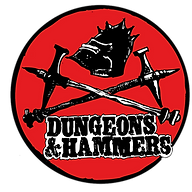What is the Tower? BSW Design Blog 2
- Dungeons and Hammers
- May 23
- 3 min read
Updated: May 30

I love the concept of tracking inventory, torches, food, etc in RPGs, but in practice it often amounts to paperwork. Tracking time and resources in the dungeon should feel immediate and urgent. It should loom over you, impossible to ignore.
Enter the Tower.
In Beefy Shotgun Wizards, you don’t track time in the dungeon, torches, rations, or other “standard” dungeoneering gear on your character sheet. All these things are wrapped up into a single, monolithic object at the center of the table: a Jenga tower.
Players draw from the tower as they progress through the dungeon, making pulls regularly when they finish a room, take a rest, or expend resources to solve a problem. Some monsters or challenges, like the Maze Master, require the players to make a draw. If the Tower ever falls, everyone dies. That’s it.
Having run eleven playtest sessions (roughly 36 hours) of Beefy Shotgun Wizards, I can safely say it has exceeded all my expectations. Time and again, the feedback I’ve gotten after the games has been that the Tower was a constant source of tension, and it was clear on the faces of the players as everyone got silent before a high stakes pull just how invested everyone was.
I wanted to replicate the feeling of reaching back into your bag and having your heart stop short as you realize the flickering torch in your hand is the last light source you have. I wanted to create a gnawing sense that an invisible deadline hung over your head that you had some agency over but that you couldn’t totally avoid. I wanted a tactile thing that had to be dealt with, which offered some randomness, but which ultimately came down to literal player action. The Tower captured that perfectly.
Many games started with folks quickly or even flippantly flicking blocks out. This sometimes created tension between players at the table (and one time resulted in a TPK when someone tried to draw a block behind their back while holding a beer in the other hand). Progressively, folks started taking the Tower more seriously and looking at it as they decided which room to try next. Folks weren’t just trying to get to the end of the dungeon in a given timeframe, they wanted to get there before the damn Tower collapsed!
As I was considering this system, some light research indicated that 25-35 is the average number of pulls on a jenga tower before it falls. My typical dungeons have 10-15 rooms for BSW, and players typically explore 7 of these in a normal session. This includes random encounters (3-4) between rooms, 2-3 rests, and 1-2 monsters or situations that cause tower pulls (meaning 6-8 more pulls).
This math is all pretty quick and dirty, but it generally means that in a 3 hour session, groups that are cautious or lucky will be at the lower end of the average while groups that are speed running rooms, resting a lot, and making flippant pulls will be in serious trouble. Either way, the Tower has just worked. I got super lucky with my back of the napkin math, but goddamn, it works. Honestly, I’m eager to playtest it with an OSR system like Mork Borg, Black Sword Hack, or Deathbringer.
What do you think of the Tower? Is it a mechanic you’d consider porting into your own game?






Interesting idea to push the dungeon crawl into the realm of horror (or, you know, Dread :)
I'm not sure it would work in every setting/game (what if the characters hire porters to carry tons of torches, or if they need anti-chaos radiation pills like in Operation Unfathomable?).
I'll be keeping an eye on the results of your experiments!
Interesting idea to push the dungeon crawl into the realm of horror (or, you know, Dread :)
I'm not sure it would work in every setting/game (what if the characters hire porters to carry tons of torches, or if they need anti-chaos radiation pills like in Operation Unfathomable?).
I'll be keeping an eye on the results of your experiments!